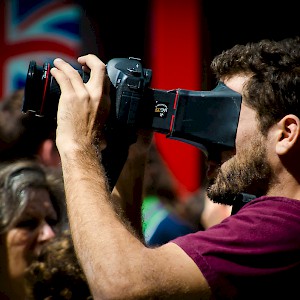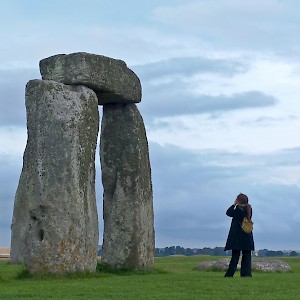Photography shooting tips

12 travel photography tips for capturing great shots on the road
Here are some guidelines for getting the pictures you want.
Shoot the details
Any postcard stand can provide you with facade pictures, panoramas, and aerial shots. You’re the only one who can concentrate on the minute details that enthrall you.
Focus on the hideous devil in a Last Judgment painting, a rivet in Tower Bridge, laundry hanging from the windows of a half-timbered house, the rough and lichen-spotted stone of a Stonehenge lintel, the door knob on a Georgian door, the time-worn face of a knight on a tomb slab.
Frame the shot
Make it interesting: Take the picture through an open window or archway or flanked by a pair of columns.
Get a thatched house reflected in a river or the town hall reflected in a puddle.
Snap a pub with racks of bicycles on either side.
If you can’t quite get the whole thing in a shot, give it up and zoom in for a detail instead.
Check your backgrounds
Nothing spoils a medieval or bucolic scene like a TV antenna, telephone poles, or tourists milling in the background.
Grab the best light
The light of early morning and late afternoon works magic on any scene, bringing out depth, deepening shadows, and warming up colors. The harsh noonday sun makes for notoriously boring pictures.
Get the sun behind you
Try to get any light source at your back or glancing in from the side if you’re going for special shadow and light effects.
One of the only times it's effective to let the light come right at you is to shoot a sun setting or rising directly behind a column or statue—a marvelous effect.
You know what you (and your family) look like
Explorers used to plant their county’s flag to claim a new territory. These days we conquer by selfie and plant the waving family. It’s nice to take a Stonehenge selfie, or snap a picture of your husband in front of Big Ben, but you don’t need to prove you were there at every single stop.
Plus, it’s more fun to get candid, action shots of the family riding the train, going on a picnic, contemplating the art in the National Gallery, whatever. Show that you traveled in and interacted with Europe, not just that you knew how to smile and wave.
Look for the unusual in the everyday
What sums up a country or culture? Half the things you’ll remember most about any trip won’t be the attractions but rather the sights and oddities of daily life over there.
Go ahead, take pictures of old men playing cards, funny little European cars, busy vegetable markets, double-decker buses, weird street signs, improbably long Welsh words, or a sheep jam on a country road.
Candid shots of people can be great, but may get some people mad. Be discreet and diplomatic.
Ask permission
It's a bit embarrassing, and it may often spoil the un-posed shot you want, but it is only polite to ask someone before taking their picture whenever possible. In some cases, people get outright mad if they catch you photographing them on the sly, whether it's a cultural thing or they're just plain shy and/or mean. Always ask.
And if you're worried they will turn rigid and pose for you, take a shot of two of the pose, then wait around until they get bored with you just standing there and go back to hanging the laundry, playing cricket, or whatever it was that drew you to them in the first place. Then you can get the shot you wanted.
Don’t be a flasher
I have a good rule for the camera flash option: Don’t use it.
Flashes are the most overrated and least understood of camera features. If you don’t know what you’re doing, the flash effects cheapen most shots, so either read up on flash techniques in a photo book or consider using it rarely, if at all. Here are a few general guidelines:
- If you take a flash photo of anything behind glass, you’ll end up with a fuzzy image of the subject (the camera usually auto-focuses on the glass, not the subject you’re trying to capture) further obscured by a bright, white star-like image that covers a quarter of the picture. That’s the flash reflecting off the glass.
- By filling in shadows with a bright, uniform light, flashes always flatten a picture out, which 99% of the time is an effect you do not want.
- Do not take flash photos of artwork. Flashes destroy paintings and frescoes, doing more damage than leaving a painting out under the sun for many days. Flash photos would make the Mona Lisa your grandchildren see a pale, faded image of itself. Also, if I see you doing it, I will yell at you in public. Seriously. I do it all the time.
Just about the only time I ever use a flash is if I’m trying to take a night shot, in which case I use the option most pocket cameras now have of a “night flash.” This option basically first exposes the low light of the background by leaving the camera shutter open for a few seconds (you have to be very still—ideally, prop the camera on something and don’t touch it), after which it flashes so that the people or object in the foreground pops out of the image in a bright pool of light. If you use just flash by itself at night, the subject will be washed-out and bright, but the background pitch black.
Wait
The perfect shot might not come out until the sun moves from behind that cloud or an un-photogenic tour bus pulls away.
On the other hand, don’t let a good opportunity slip away. If a shot is good but you think you should wait, take one picture immediately, and then stick around to see if it gets better.
Get close
Unless you’re shooting a countryside landscape, try to get within 10 feet of most subjects. Fill up the frame. Keep shots dynamic.
(And for landscapes, try to get something in the foreground at the corner or side of the frame to make the depth pop.)
Find a new angle
Choose any angle that will get you a picture different from everybody’s else’s. Remember: you can turn that camera on its end; take some shots vertical, others horizontal.
Eye-level is boring. Climb a tree, squat down, stand on a bench, hold the camera high above your head and point it in the general direction, or lie flat out on the ground.
I do it all the time, and while I get funny looks, it makes for some great shots.
- REI.com - Since 1938, one of the best all-around outdoors, camping, and adventure travel outfitter, with just about everything you need, whether you're a novice or a hard-core enthusiast. Lots of high-tech clothing designed for heavy-duty wear, tear, travel, and sport, plus everything from packs to personal mosquito nets to biodegradable detergent—and of course, all the basic gear for camping, hiking, mountaineering, mountain biking, skiing, canoeing and kayaking. It's actually run as a co-op, so if you become a member ($15 to join for life), you get 8% cash back on your purchases at the store at the end of the year (10% back if you use the no-fee, free credit card they give you, which also generates 1% back on non-REI purchases). They also have a special clearance-sale section.Partner
- Travelsmith.com - One of the best catalogues out there for travelers (not so much outdoorsy stuff), with high-quality clothing and luggage (and some gadgets) carefully selected or adapted to be perfect for traveling—durable, versatile, wrinkle-resistant, lots of hidden pockets, and sometimes even stylish. My wardrobe's full of stuff with their label on it—though in recent years, they seem to have become increasingly concerned with offering more and more fashion clothing than their old focus on true travel gear. Sad. Also, I should note that some women (my mom and my wife, to be precise) report that the women's clothing is a bit more hit-or-miss—usually excellent, but sometime a big let-down in terms of quality or looks.
- eBags.com - The name really says it all, doesn't it? This is the single best online outlet to compare every concievable type of bag, suitcase, pack, purse, backpack, shoulder bag, duffel, and every other conceivable form of carrying-your-stuff travel container out there—along with related accessories. Good prices, too.Partner
- LLBean.com - This Maine camping clothier and catalogue legend was selling flannel shirts long before Seattle produced its first garage band, and decades before J. Crew and Banana Republic co-opted the outdoorsy look and made it Yuppie. Their travel specialty gear is, as with most of their stock, head and shoulders above anyone else for durability, quality, and utility (if not always style). Best of all: "We guarantee all items for the useful life of the product." That statement is what has hooked people on this storied outfitter since it sold its first pair of boots in 1912. (Its original bricks-and-mortar store in Freeport, Maine became such a site of pilgrimage for vacationing fans of its catalog that it single handedly created the town's now world-famous outlet store industry.)
- Magellans.com - Clothing, luggage, and lots of travel gadgets—some exceedingly useful, others merely ridiculous exercises in technology (seriously, who needs a portable oxygen mask, or a silver case that automatically dispenses credit cards?). Their prices could be lower, but they do carry some prime merchandise difficult to find elsewhere and Magellan's really is the place to go when you're seeking some obscure but useful travel gadget (and I don't mean the collapsible Lexan wine glasses).
- Amazon.com - An obvious one, but a good resource to remember. Everybody's favorite one-stop shopping site on the Internet carries just about anything you could think of.Partner








